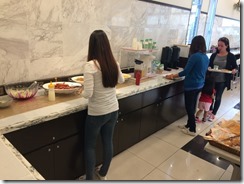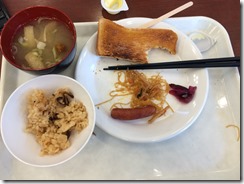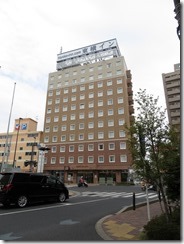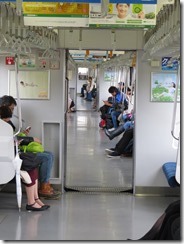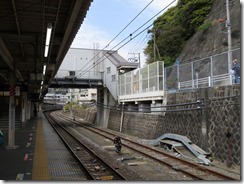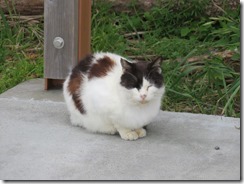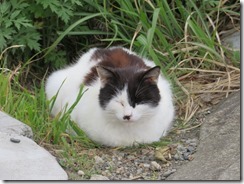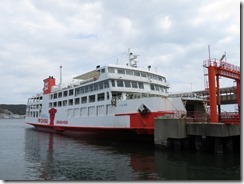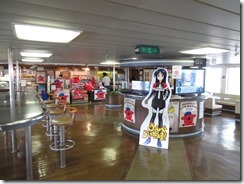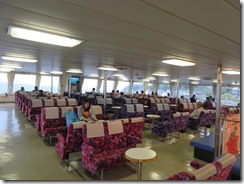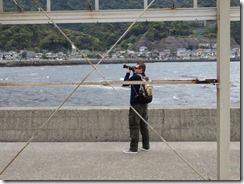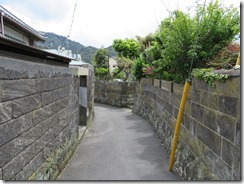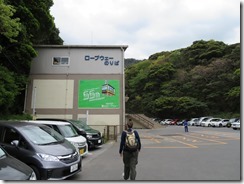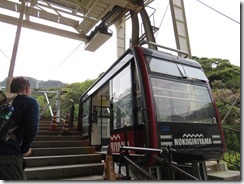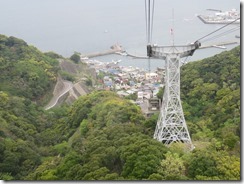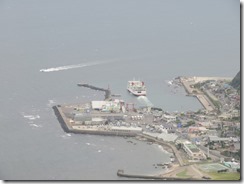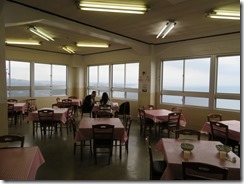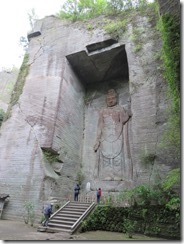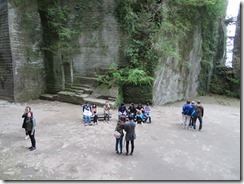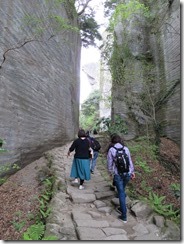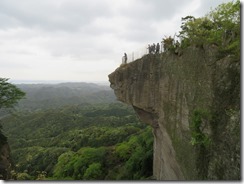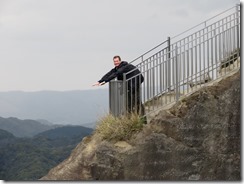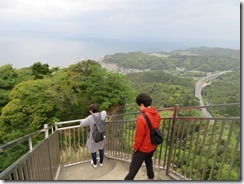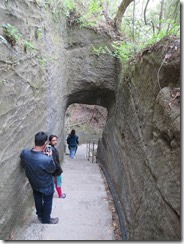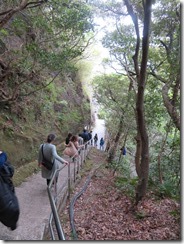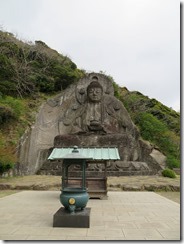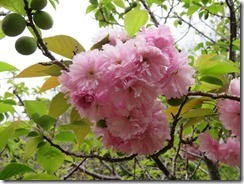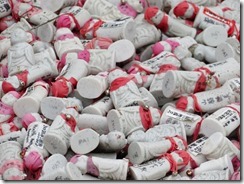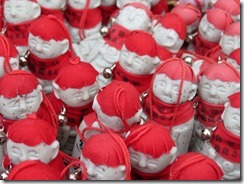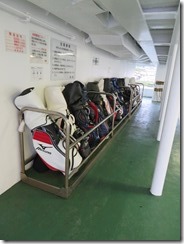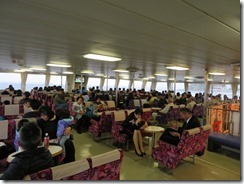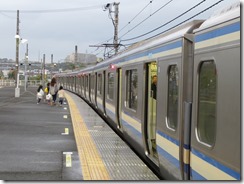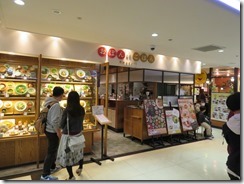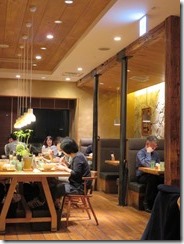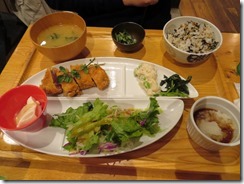Yesterday’s post now has photos.
On the subject of how all Japanese names have meanings, thanks to the meaning inherent in the kanji used to write them, a common name traditionally given to one’s first son is Ichiro. It means… “first son”. I mean, you can add some kind of virtue to it as well, like Yuichiro = brave first son, but it still means “first son”. Actually, there’s a whole series of these names – Ichiro (first), Jiro (second), Saburo (third), Shiro (fourth), Goro (fifth) and so on. I couldn’t even imagine naming someone “first son” in English. Girls got it a bit easier – traditional girls names tended to be nature related, like Hana (flower), Fuji (wisteria) or Ishi (stone), or were blessings, like Chiyo (a thousand generations), Momo (one hundred) or Toyo (abundance).
But moving on. We both slept quite well last night, though I found myself awake about an hour earlier than intended. Either way, we headed down to breakfast in the hotel lobby. I again forgot my camera. Same sort of stuff as every Toyoko Inn breakfast – rice, miso soup, assorted pickled items, something with meat, and bread for toasting. Again, I forgot the camera, so these photos come from the phone.
After breakfast, we headed out for our first day of actual sightseeing. Specifically, we were going to visit Nokogiriyama, which I attempted to visit on my last trip but was unable to, thanks to the weather. Nokogiriyama, which means “saw-tooth mountain” is located in Chiba Prefecture, across Tokyo Bay from Kanagawa Prefecture – to get there from our hotel in Chigasaki, it involved two trains, a bus, and a ferry.
Most of the summit of Nokogiriyama is the home of Nihon-ji, a temple that was founded in the year 725 (in June, according to the temple map, with curious specificity), making it possibly one of the oldest temples in Japan. During the Edo period, the side of the mountain facing Tokyo served as a huge stone quarry, and so much stone was mined that it actually changed the shape of the mountain, giving it the shape that it is now named after.
In any case, we caught our trains and bus pretty much without issue, and soon we were in Kurihama – my first time to return to a place I’d already been in Japan (aside from obvious places like Narita Airport or Tokyo Station, or the ryokan I stayed at in Kyoto). For this trip, our ferry was the Shirahama-maru. It felt a little bit smaller than the Kanaya-maru, which I took last time, and possibly a little bit older, but still extremely nice all the same. Very comfy chairs. Spotted the Kanaya-maru doing the reverse trip on the way.
Once in Kanaya, we wandered through the town a few times looking for somewhere nice to eat, but nothing was grabbing our attention. Eventually, we decided to head up the Nokogiriyama Ropeway and eat at the “cafeteria” that the brochure said we would find at the top. And fortunately, today it wasn’t too windy for it to be running. It was quite a spectacular trip up.
The ropeway ticket is printed on surprisingly heavy cardboard, and is marked as used by the attendant clipping a notch in one side with a special tools, like all train tickets used to be in Japan, making it feel quite historic.
The upper ropeway station is a four-storey building with a a lookout on the roof, and the view from up there was quite amazing. The cafeteria was on the topmost floor, it also had quite a view from the windows. I had pork-on-rice with a side of miso soup, and James had curry rice. Most tasty.
Lunch done, we headed into the temple proper. First stop on the walk, the Hundred-Shaku Kannon. Carved into the wall of a quarried ravine, it’s a statue of the bodhisattva Kannon, and it’s a hundred shaku tall. Hence the name. A shaku is an old Japanese measurement roughly equal to a foot, so it’s about thirty metres tall. It was carved in WWII to commemmorate the lost soldiers, but today it serves as a patron of safety on the roads. My first introduction to this place was when this statue in appeared the Japan special of Top Gear, being used as a finish line for a race between the hosts.
I think what I loved most about it was the absolute serenity of the whole area, both the path leading up to it, and the actual open space in front of it. They were surrounded on all sides by tall rock faces, but plants were growing everywhere, and the birds were chirping.
Next stop, Jigoku-Nozoki, meaning “the viewpoint into hell”, though I’m not too clear on what was supposed to be so hellish about the view. It’s this small rock platform which is cantilevered out over the cliff (though when you’re standing on it, it looks plenty solid). There’s actually a structure nearby that you can view it from, so James and I took photos of each other from there.
From that point, very nearly the highest point on the mountain, we headed down a long, looong line of stairs to see the Nihon-ji Daibutsu. At thirty metres tall, the Daibutsu (“big buddha”) is described in various places as the largest pre-modern, stone-carved buddha statues in Japan, which seems like it’s been excessively qualified to make it sound more impressive, but in actual fact it towers over the eighteen-metre statue in Todaiji (which we saw on our first trip), and the thirteen-metre statue at Kotoku-in in Kamakura (which I saw on my second).
I also saw some pink flowers blooming nearby. I went to check them out, wondering if maybe they’d be some late-bloomong sakura, but on closer inspection, I rather suspect it was a peach or plum tree. I’m no botanist, though. Rather pretty all the same. In addition, we saw a statue of Jizo with a whole mound of tiny Jizos standing around its base – turns out you buy them from the temple, write your wish on them, and leave them for Jizo to grant.
Once we were done there (and got my belated goshuin), we strolled gently back up the stairs on the other side of the complex to return to the ropeway station. We managed to get back there at 3:55, thinking the final trip would be at 5pm (according to the ropeway brochue), but we discovered when we got there that it’d actually be at 4pm. That was cutting it close, whew. But that’s another thing I can check off my stuff-to-do-in-Japan list.
For much of the time from lunch to here, it was attempting to rain, despite the weather report promising only a 40% chance in the late afternoon. I’d bought an el cheapo umbrella in the morning in an attempt to employ the anti-rain magic of lugging an umbrella around all day, but unfortunately I’d forgotten that if the weather is too windy to use the umbrella – as it was today – that magic gets negated. Fortunately, it never rained particularly hard, or for very long.
At the bottom, we walked back to the ferry port just in time for the 4:30 ferry (Shirahama-maru, again), hopped on the bus waiting for us, and then got on the train. Finally learnt what the strange racks I’d seen on the ferry were for – golf bags. And on this trip, they were full of them.
At Ofuna Station, we decided to head out of the station to find some dinner, eventually settling on a place called “Obon de Gohan” which specialised in teishoku cuisine, or meal sets – a main dish with a bunch of different sides. James had some kind of battered seared tuna, and I had nanban-style fried chicken with a miso-based tartar sauce. Very tasty.
Also, the waitress who took our order could speak pretty good English, having spent three years studying at university in the Gold Coast. She was quite impressed with my Japanese, which I kept using (a) from force of habit, and (b) because I was reading from the Japanese menu (they’d only given us one English menu, and James was holding it).
With dinner done, we headed back to the hotel. Currently I’m looking at tomorrow’s forecast (100% chance of rain at night, falling to 40% at breakfast time, and nothing the rest of the day) and pondering whether or not I need to modify tomorrow’s plans…
Today’s photo count: three hundred and seventy-five.
Today’s pedometer count: 16,260 steps, or 11.9 km. James’ smart watch is also telling him he’s climbed the equivalent of eighty storeys in stairs.
Today’s goshuin count: One – Nihon-ji, finally.
Today’s stamp count: Four – Kurihama Station, a second stamp that was at Kurihama which I’m not sure what it was for and stamped poorly anyway, the Shirahama-maru, and two little stamps at the Nokogiriyama Ropeway which I decided to put on one page (one of which I stamped sideways).

